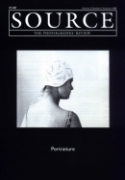In the Hunter's Space
'In the Hunter's Space' by Hannah Collins was at the Irish Museum of Modern Art, 1996
Review by Nicholas Allen
Issue 9 Autumn 1996
View Contents ▸
Hannah Collins impressive collection of work is ideally situated in the Irish Museum of Modern Art. It hangs along a corridor and is spaced through a series of anterooms. All are white. The main images are approximately three by eight metres, black and white and striking. The first is coincidentally the one that entices the most. Entitled 'The Hunters Space - In the Course of Time - The Road to Auschwitz' it details (and for once this word is entirely correct, so large is the image that even the smallest of branches seem to be dangling in your face) a deserted scene of bending road and naked tree, half covered in snow. At first you feel like you're standing there, in the picture. Then the planes of reference make you disorientated. The right quarter of the image is cordoned off by the twist of a road which forms a semicircle whose other half can only be guessed at. Does it indeed go anywhere? Buildings rest on the left hand side. They are hyper-real as the image has been treated to allow little contrast, thus making the sky the same colour as the snow covered ground. There is a curious 3-D effect about the whole scene. The more you stare at it, the more the darker parts seem to bulge out at you. And all this without the aid of hallucinogens. This form of contact with the image before you is not sustained through the entire exhibition and with good reason. There is a subtext to the show which chronicles the traces of the lost and dispossessed. When this touches upon the still sore ground of the Holocaust such a drawing into the scene may be at best only a pastiche and at worst voyeuristic. The Hunters Space - In the Course of Time - The Road to Auschwitz
The Hunters Space - In the Course of Time - The Road to Auschwitz
The mention of Auschwitz in the first image is telling through the link it suggests to many of the other works in the show. There is an affinity suggested between the photographer and the people who pasted through the area before her. This is an extremely problematic link but to her credit Collins fields the danger and directs her attention from human portraiture (how you can imagine the monochrome image of the bravely smiling peasant) to a concern with the inanimate. Nothing too original about that you might think but the results are often surprising. 'In the course of Time XIII, Small Door, Krachow' dwells on shower curtains and pipes with nozzles. Combined with their appearance in a factory site the reference is clear. Yet even in this context the most apparently referential works take on an other-worldy quality. In 'Huta Chemical Works, Silesia' photojournalism becomes fairytale as abandoned cars and high walls with a road winding over a bridge in the distance suggests the secrecy of former lives that held a character not reflected in the title or it's supposed subject.
'In the Course of Time (Gypsies Camp II)' has as background a train speeding across a bridge. Almost hidden from view is the collapse of a gypsies camp which titters towards the river bank in a pale imitation of the mechanics above it. It is perhaps only in a settled mind that the image can at first seem so cut and dried, the dichotomy between two levels of technology (one inferior, one superior) so immediately apparent. On further reflection, Collins has managed to capture the spirit of the travelling people very well. For if their camp fell it was surely meant to do so. It is sometimes not so easy to recognise that the obvious translation lies at first within yourself. It is in such allusions to the temporary that the fairytale of Collins succeeds. For what more is a fairytale than the telling of a story simply with the constant hint of deeper significance? Collins leaves you with the feeling that the big bad wolf is never too far away.
Other articles by Nicholas Allen:
Issue 4: Reviewing My Insolent Ontologies - The Family Album [Review] ▸
Issue 13: Causality and Contingency - Irish Landscape Images [Review] ▸
Other articles on photography from the 'Historical' category ▸






